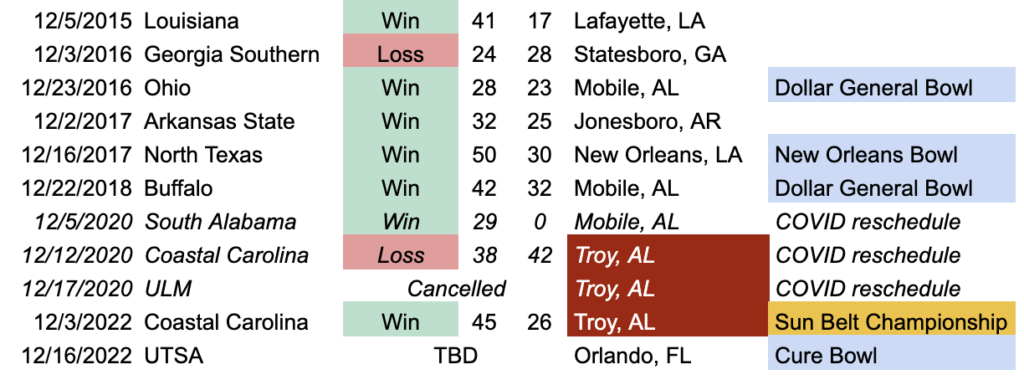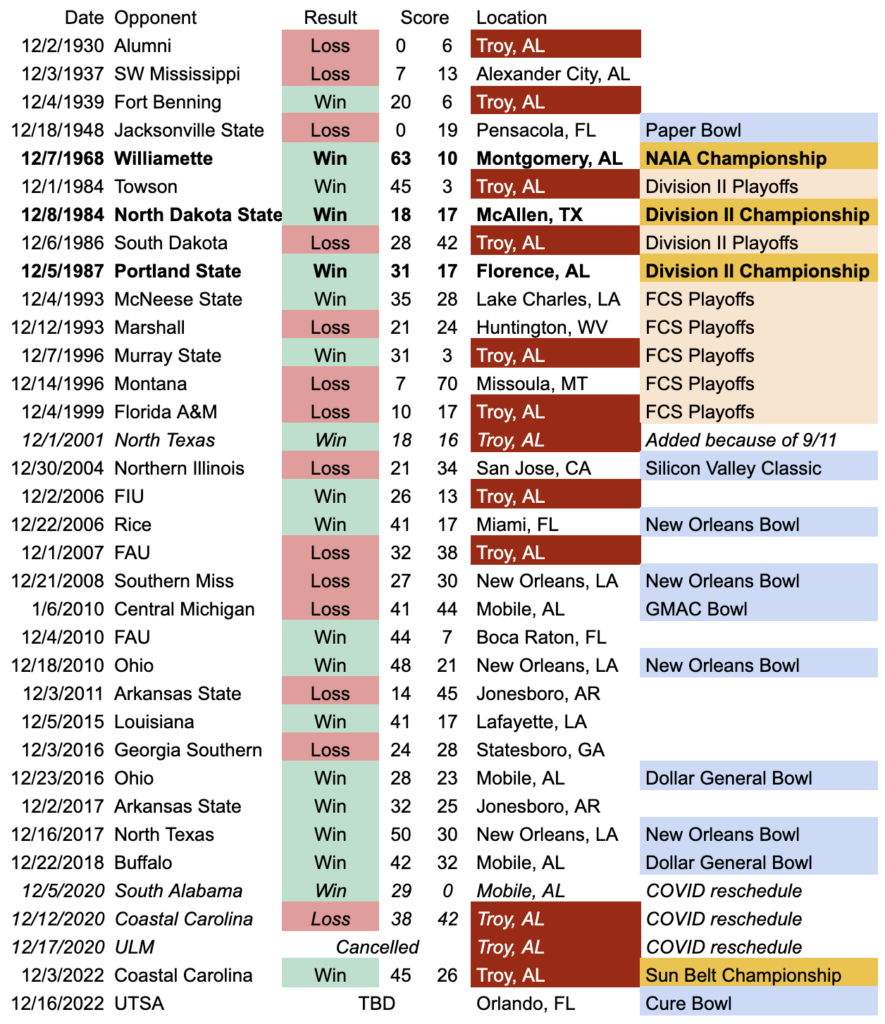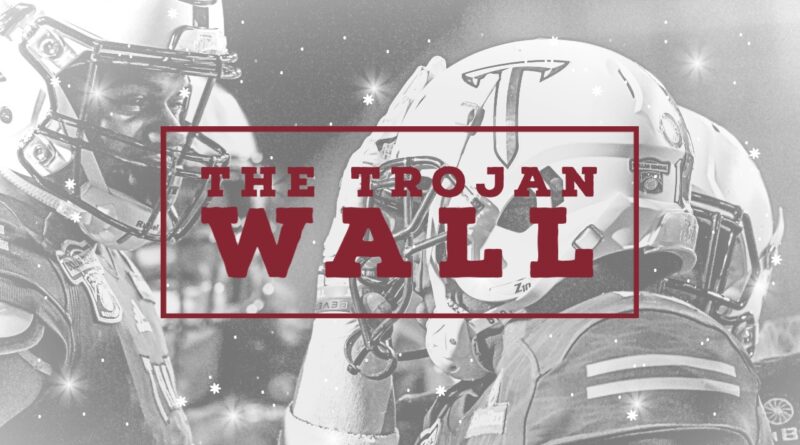The Cold Never Bothered Us: Troy’s December Results
The 2022 Trojan football team will forever be defined by the way it recovered from the Miracle on the Mountain. Troy rattled off 11 wins to date, with the opportunity for a 12th on Friday.
The Cure Bowl, as a postseason game, is a symbol not only of Troy’s success on the field this season, but as a program as well. It will be Troy’s 34th game in the December calendar month or later.
On its move from small college status to the FBS, Troy has proven its worth at the end of its seasons, not only by earning postseason play… but by winning in it as well.
This history stretches 92 years. Let’s go though it one step at a time.

The Pre-NCAA era
Troy’s first December game was the infamous “Alumni” game. The media guide lists it as a December 2 game, although contemporary reporting pushes the date back to November 22, aligning with a homecoming event.
Seven years later, the Red Wave headed two hours up the road to Alexander City. Troy played Southwest Mississippi Junior College in what was effectively a postseason exhibition.
The field was hardly neutral territory, though. Coach Albert Choate, former Tallapoosa High School coach, still had a rivalry with I.I. Fox, the former Alexander City coach who took over at SW Mississippi.
Fox got the last laugh, swiping a 13-7 win over the Red Wave.
Troy’s only December win before World War II came when it hosted Fort Benning in 1939, one of four matchups in 16 years. The Red Wave won 20-6.
Almost a decade later, the Red Wave played their first official bowl game against Jacksonville State… the infamous Paper Bowl. The week was fantastic but the outcome not so much.
Troy didn’t play in December for another 20 years, when the Red Wave won the 1968 NAIA National Title over Willamette, 63-10. Not long after that, the Red Wave moved into the NCAA and changed its name to the Trojans.
The team only played two December games in a 45-year span… only ending with another playoff run.

The Playoffs era
Troy tripled its December appearances over the next 17 years, mostly thanks to playoff runs in the 1980s and 1990s.
Chan Gailey brought Troy its second national title in 1984, capping a five-game win streak with a blowout win at home and a last-second victory in Texas—both in the final month of the year.
Gailey left, Rhoades took over and he almost left early himself. Instead, Troy followed its 1986 playoff loss with another D-II title. This time, Rhoades did leave.
Four years and a coach later, the Trojans hired Larry Blakeney to guide them to Division I-AA. He succeeded, and in 1993, the Trojans began a run at the unthinkable: an undefeated season.
Troy’s perfect national title hopes were dashed in Huntington, West Virginia, when current Sun Belt opponent Marshall edged the Trojans 21-24. Blakeney pushed forward, and Troy made the playoffs six of the next seven years.
All of these runs ended in defeat though, just short of further glory. Despite missing out on a fourth title at a third level, Troy began another move up… to Division I-A.
It finally happened in 2001. You can read about the entire season here.
The September 11 attacks had a massive impact on the college football season, but the only real fallout in Troy was the loss of a game against current Sun Belt foe Appalachian State… and the late addition of former Sun Belt foe North Texas.
Troy beat the Mean Green 18-16, securing a winning 7-4 record in its first season at the I-A level.
Three years later, it joined the Sun Belt Conference.

The Five-peat Era
The Trojans’ first modern bowl appearance was the pinnacle of its first season in the Sun Belt, a matchup with Northern Illinois in San Jose, California.
That game had its own issues, like weather, but the Trojans came up short.
Two years later, arguably the most successful stretch of Troy football began. The Trojans won five straight Sun Belt titles, making appearances in four bowl games.
In 2006, Troy earned its first bowl win, dismantling Rice 41-17. The Trojans didn’t feel that joy for another four years.
The next two bowl games, in 2008 and January 2010, both ended in heartbreak: overtime losses to Southern Miss and Central Michigan. I included the GMAC Bowl despite its January date, for complete context.
Finally, the fifth title brought things full circle, with a 48-21 win over Ohio in the same bowl where Troy first tasted victory.
Sprinkled throughout the five-title run were a handful of regular season December games. With the exception of the 2001 North Texas game, Troy had not played a regular season game in December since 1939.
The 2006 FIU game was Troy’s first regularly-scheduled non-playoff, non-bowl December game in 67 years. Five years and a day later, Coach Blakeney lost to Arkansas State 14-45.
It would be his last December game, but he coached for another three seasons.

The Post-Blakeney Era
Neal Brown’s first season ended in a December victory… at Cajun Field. As difficult as that environment is, and despite the team’s 4-8 record, the 41-17 smackdown felt like a bowl victory (even had the same score as the 2006 New Orleans Bowl) and gave the 2016 Trojans momentum.
The following season, Troy secured a bowl spot earlier in the season than ever before. In fact, it was a week earlier than the 2010 season.
But the Trojans had another December regular season game. It happened in back-to-back-seasons (2006-07, 2010-11, 2015-16) and Troy had never won in the second of the two seasons.
Also, a share of the Sun Belt was on the line. No pressure.
Troy lost a heartbreaker to Georgia Southern, missing out on the team’s first 11-win FBS season. A trip to Mobile and a first bowl win there made up for it, though.
The next season, Troy was in a similar situation. The only differences were an extra mark in the win column and an opponent who was fighting for the title as well.
Troy pulled off the win in Jonesboro, catapulting the sixth-time Sun Belt Champions back to New Orleans. Brown’s Trojans squashed North Texas that year, and Buffalo the next, in a return trip to Mobile.
The 42-32 win was Brown’s last as Troy head coach.
Chip Lindsey’s Trojans never sniffed a winning record, so it took the pandemic for Troy to play December football. Three games were rescheduled: South Alabama, Coastal Carolina and ULM.
The Battle for the Belt move actually impacted our Battle for the Belt content schedule that year.
Troy smothered South Alabama 29-0 in Steve Campbell’s last game as head coach, the Chanticleers pulled off another close victory, and ULM had too many players out with COVID to even play the final game of the 2020 season.
This season, first-year coach Jon Sumrall brought Troy its first post-COVID December game, the Sun Belt championship. It was the first time Troy hosted the game in its short history, and the Trojans cruised to a 45-26 win over Coastal Carolina… finally getting revenge for the three previous years of close losses.
The Trojans now have a second December game, the 2022 Cure Bowl against fellow top-25 conference champion UTSA. If the Trojans win, it will extend its bowl streak to five wins.
It will also give Troy its 20th December victory.

Right now, Troy is 19-13 in the month of December (19-14 if you count the 2010 GMAC Bowl). It’s 7-2 going back to the beginning of the Neal Brown era.
Clearly that was the most successful coach, with just the one loss in 2016, but Larry Blakeney, despite going 7-8 and having the most losses, is the coach by which Troy football history is measured.
I literally divided up each part of this article based on his accomplishments (and the 1968 title). There’s a reason his name is on the field at the Vet.
Overall, the timeline is reflective of the Trojans’ tenacity as a team and a program. Every time you might see a string of losses, a streak of wins is guaranteed to follow.
The Trojans don’t quit until the calendar runs out.

